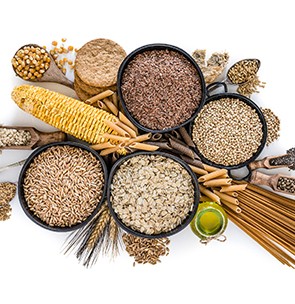

Published on Mar 29th, 2022

Are you fond of whole grains and ever wondered to pick them every day in your dietary schedule? If yes, then you should know how you can do this by simply reading this article. All you have to do is firstly examine what it keeps to make your diet healthy and super nutritious. If not, then read this article to know its endless benefits.
Our body system fundamentally requires nutrients to stay active and fit. Whole grains serve us with phenomenal three parts - the bran (the nutrient oriented outer layer, the germ (the seed's nutrient-rich embryo), and the endosperm (the germs food supply, which is excessive in starchy carbs).
Whole grains are ordinary grains that have all three components. They usually have a high quantity of vitamin B, fiber, protein, antioxidants, magnesium, manganese, phosphorus, selenium, copper, and zinc.
A whole grain contains all wholesome areas of the grain, together with the bran, germ, and endosperm. The whole grain may be used commonly or mixed, as long as all elements have existence in natural proportions. To identify whole grains we have to introduce you to their names and their health advantages.

Whole Wheat has a prominent and awesomely versatile cereal grain. It’s a primary ingredient in baked kinds of pasta, noodles, bulgar, couscous, and semolina.
We all know that wheat is very famous and extremely controversial in terms of its gluten involvement. Gluten is a protein that can provoke a terrible immune response in certain people. However, if your health can bear the dose of gluten then you can freely take whole wheat as it is the ultimate source of vitamins, minerals, antioxidants, and dietary fiber.
There is a difference between ‘whole wheat’ and just ‘wheat’. Be conscious while selecting between the two. The whole wheat contains the entire grain, along with the fibrous husk, bran, and endosperm. Moreover, common wheat is stripped of the husk and bran, which are packed with nutrients.
Oats are among the yummiest whole grains you can add to your diet. They are not only loaded with vitamins, minerals, and fiber but also have a gluten-free quality.
Oats are super-rich in antioxidants, specifically avenanthramide. This antioxidant has been connected to a minimum risk of colon cancer and lower blood pressure.
Oats are also a good source of beta-glucans, a type of soluble fiber that supports digestion and nutrient absorption.
Brown Rice is highly famous as a healthier substitute for white rice. Concerning it’s a whole grain, meaning it contains the overall grain in terms of bran, germ, and endosperm. However, white rice has both the bran and germ eliminated. As the bran and germ are nutrient-oriented, brown rice contains extreme fiber, vitamins, minerals, and antioxidants.
Brown rice is also purely gluten-free, allowing it to have a great and well qualitative dietary routine. Brown rice has a great source of lignans, which are antioxidants that reduce the risk of heart diseases by normalizing blood pressure, inflammation, and cholesterol.
Whole Grain Bread products are an effortless way to include whole grains in your diet. They are commonly available and come in many different varieties such as rye bread, whole wheat bread rolls, whole grain bagels, whole grain tortillas, and others. The grains and legumes in this bread are sprouted, considering they have been soaked in the water allowing them to germinate. This increases their nutrient quantity and decreases antinutrients that are usually found in whole grains.

Whole grain kinds of pasta are made from pure wheat grain. Due to this, they have more vitamins, minerals, and fiber than regular pasta. A big appreciation to their higher fiber content, whole grain pasta tends to be more filling. Therefore, they are made from whole-wheat flour which is a grind. This shrinks many of the amazing effects of whole grains, which means whole grain pasta is not as healthy as complete whole-grain foods like brown rice and quinoa.
If you want to eat pasta, it’s great to choose whole grain over ordinary pasta as it contains fewer calories, more nutrients, and has more filling fiber.
Rye is a component of a wheat family and has been consumed for centuries all over the world. It’s commonly more nutritious than wheat and contains more minerals with lesser carbs. That’s the only reason why rye bread doesn’t raise blood sugar in comparison to wheat.
Another benefit is that rye flour is greatly high in fiber. Rye flour is available in the market in various forms such as light, medium, dark, rye meal, and pumpernickel.
Both light and medium varieties are generally more refined and not considered whole grain, whole dark rye flour, rye meal, and pumpernickel flour are more likely to be whole grain.
Healthy and tasty whole grains are a blessing when you are hungry and want to eat some snacks, you can quickly switch to whole grain bread, pasta, brown rice, and oats. It completely satisfies your cravings and triples the energy of your body. Whole grain has splendid merits that make it a proper and delicious diet for everyone.
BackBe the first to know about new products, events and offers.